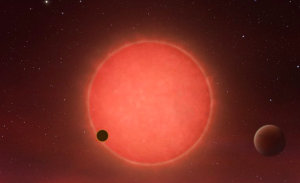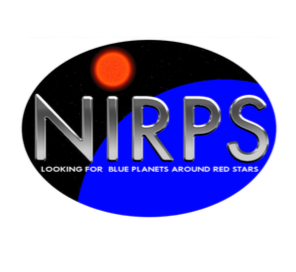Science
La Silla Paranal Observatory: a hub for extrasolar planet research
 Our knowledge on the frequency of planets, the architecture of planetary systems and their nature (mass, size, bulk composition, atmosphere) has been revolutionised in the last two decades thanks to various detection techniques providing complementary measurements. Observational efforts were undertaken with ground- and space-based facilities, notably radial velocity (RV) surveys using high-precision spectrographs and transit surveys from space (CoRot and Kepler) and from the ground (WASP, HAT, etc.). The upcoming space armada headed by the launch of the JWST (2018), and followed by TESS (NASA, 2018), CHEOPS (ESA, 2018), and PLATO (ESA, 2026), will spark a new revolution in the field of extrasolar planets only if it is complemented with efficient ground facilities. The La Silla-Paranal Observatory has a key role to play as it already hosts prime ground-based planet-finding facilities. These instruments approach exoplanet study through radial velocity (HARPS, CORALIE and upcoming ESPRESSO), transit measurement (NGTS) and high-contrast imaging (SPHERE, PCS on the ELT). NIRPS will complement these instruments, allowing precise RV measurements in the nIR with a 1 m/s precision, and specifically target the detection of low-mass planets around the coolest stars. The NIRPS survey will provide an in-depth monitoring of all Southern nearby M dwarfs, complementary to large-scale surveys, such as APOGEE[20], that probe >1000 of M dwarfs for giant planets and brown dwarf companions.
Our knowledge on the frequency of planets, the architecture of planetary systems and their nature (mass, size, bulk composition, atmosphere) has been revolutionised in the last two decades thanks to various detection techniques providing complementary measurements. Observational efforts were undertaken with ground- and space-based facilities, notably radial velocity (RV) surveys using high-precision spectrographs and transit surveys from space (CoRot and Kepler) and from the ground (WASP, HAT, etc.). The upcoming space armada headed by the launch of the JWST (2018), and followed by TESS (NASA, 2018), CHEOPS (ESA, 2018), and PLATO (ESA, 2026), will spark a new revolution in the field of extrasolar planets only if it is complemented with efficient ground facilities. The La Silla-Paranal Observatory has a key role to play as it already hosts prime ground-based planet-finding facilities. These instruments approach exoplanet study through radial velocity (HARPS, CORALIE and upcoming ESPRESSO), transit measurement (NGTS) and high-contrast imaging (SPHERE, PCS on the ELT). NIRPS will complement these instruments, allowing precise RV measurements in the nIR with a 1 m/s precision, and specifically target the detection of low-mass planets around the coolest stars. The NIRPS survey will provide an in-depth monitoring of all Southern nearby M dwarfs, complementary to large-scale surveys, such as APOGEE[20], that probe >1000 of M dwarfs for giant planets and brown dwarf companions.
M dwarfs: a shortcut to habitability and life
The detection of life beyond Earth is arguably still a few decades away, and will require substantial further technical developments. Regardless of how distant the answer to this question might be, the roadmap leading to it has been already traced and consists of well-defined sequential steps:
- Finding transiting or directly imaged planets in the habitable zone (HZ) of cool stars using ground- and space-based photometric surveys and characterizing their orbits, masses, density and bulk composition;
- Characterizing the atmospheres from space or from the ground in the most favorable cases;
- Seek chemical imbalances as tracers of potential biosignatures.
 While the detection of an Earth analog around a Sun-like star requires a precision of better than 10 cm/s, M dwarfs offer a more accessible and attractive means to the goals above. The amplitude of the RV signal scales with m-2/3, where m is the mass of the star. In addition, due to their much lower luminosity, the HZ is typically 10 times closer than in the case of Sun-like stars. These combined effects imply that for a mid-M with an Earth-mass planet receiving an Earth-like insolation, this RV signal is on the order of 1 m/s and therefore detectable with state-of-the art RV spectrographs. As M dwarfs are cool and emit most of their flux in the nIR, one ideally needs to obtain RV measurements in this domain to reach the highest possible precision. Furthermore, for a fixed planetary radius, the depth of a planetary transit scales with 1/r2, where r is the stellar radius, easing significantly transit follow-ups of Earth-sized planets around low-mass stars.
While the detection of an Earth analog around a Sun-like star requires a precision of better than 10 cm/s, M dwarfs offer a more accessible and attractive means to the goals above. The amplitude of the RV signal scales with m-2/3, where m is the mass of the star. In addition, due to their much lower luminosity, the HZ is typically 10 times closer than in the case of Sun-like stars. These combined effects imply that for a mid-M with an Earth-mass planet receiving an Earth-like insolation, this RV signal is on the order of 1 m/s and therefore detectable with state-of-the art RV spectrographs. As M dwarfs are cool and emit most of their flux in the nIR, one ideally needs to obtain RV measurements in this domain to reach the highest possible precision. Furthermore, for a fixed planetary radius, the depth of a planetary transit scales with 1/r2, where r is the stellar radius, easing significantly transit follow-ups of Earth-sized planets around low-mass stars.
Although HARPS was optimized to obtain high radial velocity measurements for Sun-like G and K dwarfs, a large fraction of HARPS nights were allocated to monitor M dwarfs over the last decade. Following the discovery of a Neptune-like planet around the M3V Gl581[1] more than a decade ago, a large number of planets were uncovered around M dwarfs despite the fact that these stars are particularly faint at optical wavelengths[2]. Significant discoveries include the first planets orbiting in an M dwarf habitable zone[3] (Gl667Cc) and an Earth-mass planet around our nearest celestial neighbour, Proxima Centauri[4]. In collaboration with photometric survey, HARPS played a key role in discovering and characterizing transiting planets around M dwarfs, paving the way toward their atmospheric characterization [5,6,7,8].
Several studies produced initial estimates of the fraction of M dwarfs hosting Earth-like planets inside the habitable zone. Results based on transits[9,10] and radial velocity measurements (HARPS)[11] all suggest that Earth-sized planets are abundant around M dwarfs, showing that at least 40% of these stars have such a planet in their HZ. Such a high rate is encouraging and provides a strong argument for shifting the attention of exoplanet searches to M dwarfs, which in turn requires a shift towards the nIR.

This artist impression shows a sunset seen from the super-Earth Gliese 667 C c[3]. The brightest star in the sky is the red dwarf Gliese 667 C, which is part of a triple star system. The other two more distant stars, Gliese 667 A and B also appear in the sky to the right. Gl 667 C is among the M dwarfs that are bright enough to be observed with HARPS. NIRPS will allow to study a much larger sample of M dwarf systems. Credits: ESO
- [1] Bonfils et al. 2005 A&A 443, L15
- [2] Astudillo-Defru et al. 2017 A&A 602, 88
- [3] Delfosse et al. 2013, A&A 553, 8
- [4] Anglada-Escude et al. 2016, Nature, 536, 437
- [5] Charbonneau et al. 2009, Nature 462
- [6] Almenara et al. 2015 A&A 581
- [7] Berta-Thompson et al. 2015 Nature 527, 204
- [8] Dittmann et al. 2017, Nature 544, 333
- [10] Dressing & Charbonneau 2015, ApJ, 767, 95
- [11] Bonfils et al. 2013, A&A, 549, A109
